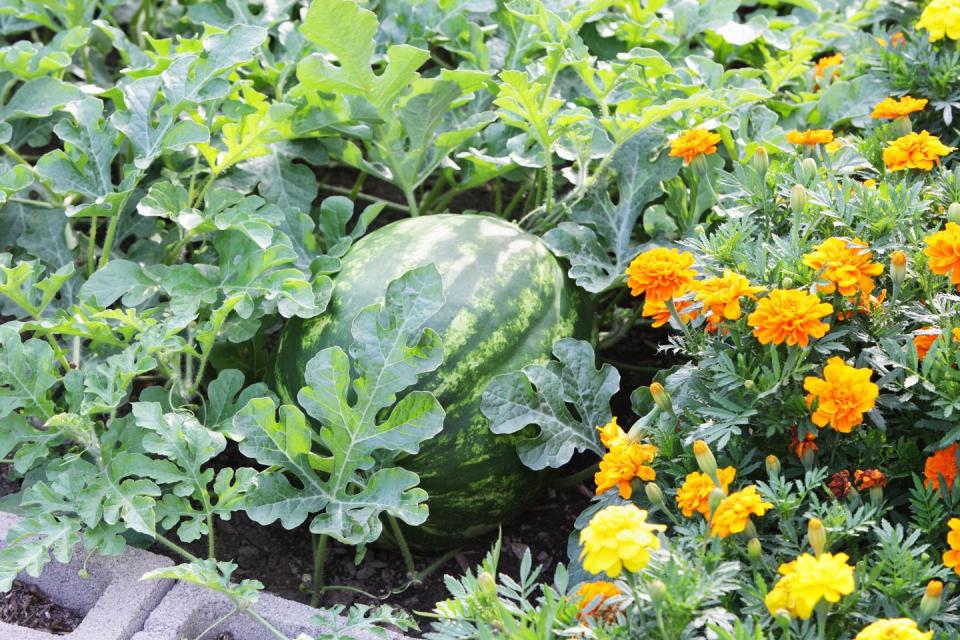Grow Your Own Sweet, Juicy Watermelons This Summer

"Hearst Magazines and Yahoo may earn commission or revenue on some items through the links below."
Is there anything more refreshing on a hot summer day than a juicy slice of watermelon? Possibly the only way to top it is if that watermelon ripened in the sun in your very own garden. Fittingly, watermelons thrive in heat and are native to desert climates in Africa and Palestine. “They typically need about 80 days to mature with soil temperatures consistently above 70 degrees,” says Venelin Dimitrov, senior product manager of vegetables, herbs and fruits at Burpee. “But it’s possible to grow them in most parts of the country if you start seeds early indoors.”
Once this sweet summer treat is fully ripe, you can bring it to a picnic, mix up a cocktail, use it in a recipe, or just cut it up to eat plain and simple. But first, here's how to plant and grow a watermelon yourself.

How do I start watermelon seeds indoors?
In some climates, such as the Northeast or Pacific Northwest where it takes longer to warm up, start your watermelon seeds indoors so seedlings get about a two- to three-week head start before you put them in the ground. Choose 3- to 4-inch peat or other biodegradable pots so you can plant the whole thing and prevent transplant shock when you put them in your garden. Put two to three seeds per pot about ¼ to ½ inch deep and cover with soil and water. When the risk of frost is past, plant the whole thing in your garden.
How do I plant watermelon seeds in my garden?
In more temperate parts of the country, direct sow watermelon seeds in ground after all danger of frost is past. Make sure they have full sun, which is at least six hours per day—though more is better! Add a balanced 10-10-10 fertilizer to the area according to package directions. Poke a hole in the soil, place them about ½ to 1 inch deep, lightly cover with soil and pat down. Put four to five seeds per hole because birds and other critters sometimes go after them. Keep watered until germination; you’ll see sprouts in about five to seven days. When the plants get their first three leaves, thin them out so that two to three hardy-looking seedlings remain. Use mulch or straw around the plants to keep down weeds and retain moisture.
Watermelons need ample space.
Traditional varieties require an area about 10 to 20 feet wide. Planting them at the edge of the garden with a fence they can climb is a good idea, says Dimitrov. Modern hybrids, which produce smaller “single-serve” type melons, need about 4 to 5 feet of growing space. Many of these hybrids also can be trained up a trellis, and the fruits can be suspended in nets and tied off to the structure to support them as they grow. Unlike many other edibles, watermelons don’t do great in pots, but you can grow them in raised beds, which help the soil heat up faster. No pruning is needed, though you can redirect the vines if they’re on the garden path by gently lifting and moving them out of the way, says Dimitrov.
Are seeded or seedless watermelons better to grow?
Which you choose is a personal preference. What you should know is for seedless watermelons, some of the seeds in the package are different colors. Because seedless watermelons cannot produce fruit without a pollinator, seed companies include some seeded watermelon seeds to plant alongside the seedless types. Do make sure to sow some of each color seed, and also plant flowers alongside your garden for the pollinators. Watermelons produce both male and female flowers that need to be pollinated by their tiny winged friends. No pollination=no fruit!

Watermelons need water, lots of water.
To become a watermelon, not surprisingly, these fruits need to be watered steadily all season long. In some parts of the country, you’ll get plenty of rain, but if the area where you live has dry spell, give them a drink about once a week. To make that easier on you, use a drip irrigation system, such as a soaker hose that delivers water directly and efficiently to the roots. If you’re watering by hand with a hose, let it trickle out slowly, directing water toward the roots, not the leaves. When the fruit starts to form, then you can cut back on watering so the sweetness is concentrated!
How can I tell when watermelons are ripe?
Watermelons stop developing as soon as you snip them off the vine, so you can’t harvest them too soon. They’re not like tomatoes, which will continue to ripen if you pick them green and set them on your kitchen counter, says Dimitrov. Read the seed package, which will tell you the number of days to maturity, to get a general sense of when they’ll be ready. Also, look at the rind color. The contrast of colors becomes sharp and clear, as opposed to all green, and the bottom spot that touches the ground will go from white to yellow when ripe. Finally, the little tendrils on the vine turn from green to brown when they are ready to eat.
You Might Also Like


